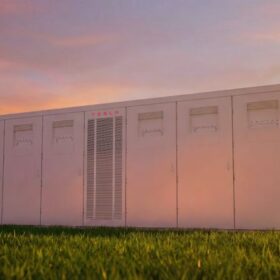Top News
BNEF flags potential global solar slowdown in 2026 as China cools

Aiko achieves 34.76% efficiency for 2-terminal perovskite-silicon tandem solar cell

Neoen begins construction of Tesla Megablock battery in Australia
The pv magazine team wishes you happy holidays and a wonderful start to the new year!

SunRise Arabia Clean Energy Conference 2026
Join the 3rd SunRise Arabia Clean Energy Conference on April 22, 2026, in Riyadh to explore how solar PV and energy storage are powering the Kingdom’s growing digital economy — including data centers. Secure your spot at the early-bird rate.
Battery Business & Development Forum 2026
Connect with Europe’s energy storage leaders at the Battery Business & Development Forum 2026 in Frankfurt (March 31–April 1) and gain insights into evolving business models, financing strategies, and market trends
Out now - pv magazine Global Winter Edition
The new pv magazine Global edition is out now!
Available in print and digital – get your copy today!
Special Edition Genera 2025
On the occasion of Genera 2025, pv magazine is publishing a special edition on the latest developments in the Spanish photovoltaic market.
Content available in Spanish.
Media Kit 2026
Special Edition Energaïa 2025
On the occasion of Energaïa 2025, pv magazine is publishing a special edition on the latest developments in the French photovoltaic market.
Content available in French.

Singapore team develops durable perovskite-silicon tandem solar cells

Research shows vacuum melting is key to efficient silicon kerf recycling
Solar glare forces panel removal at Amsterdam Airport
Off-grid floating PV-desalination system for hydrogen production
The Hydrogen Stream: CMB.Tech secures China green ammonia offtake
Press Releases
Arrival of the 5MWh Energy Storage System Marks Jinko ESS’s Continued Expansion in the Australia Mining Sector
Steadfast in ESG Action, Gokin Joins RE100 with 2030 Goal
JDEnergy delivers a 4 MWh C&I energy storage project in Germany
Fox ESS Tops Residential Energy Storage Market Across Europe and Beyond
Opinion & Analysis
Featured
Too much to choose from, too little to decide
Building resilience amid intensifying weather events
In its latest monthly column for pv magazine, IEA PVPS shows that with climate-specific site selection, robust design, proper installation, and proactive O&M, most PV systems can be made resilient and remain reliable despite intensifying weather risks.
Solar, wind and storage: stable prices, stable grid
In its latest monthly column for pv magazine, the International Solar Energy Society (ISES) explains how Australia’s rapid expansion of solar and wind energy has not increased wholesale electricity prices, which have remained stable since 2016. Rooftop solar, now widespread and highly cost-effective, provides the country with resilient, low-emission power, making all-electric homes increasingly independent from the grid.
Tracks of low-pressure systems split Europe’s solar performance in November
In a new weekly update for pv magazine, Solcast, a DNV company, reports that Europe’s solar generation potential in November showed a strong east–west split, with Eastern Europe experiencing 15–20% below-normal irradiance due to persistent storms, while much of Western and Central Europe recorded 15–20% above-average levels under clearer conditions. The Atlantic coast was an exception, as Storm Claudia reduced irradiance to near or below average in Portugal, the British Isles, and parts of France and Spain.
‘We have to hire on merit, but ensuring merit is truly visible’
This week, Women in Solar+ Europe features Sonia de Sales, Director of Development at Spain’s Altano Energy. She emphasizes that implementing an equal-opportunities plan is key to ensuring open and fair recruitment, including balanced shortlists and actively sourcing female candidates when they are underrepresented, while hiring on merit and making it clearly visible
China TOPCon cell prices dip despite looming cost pressures
In a new weekly update for pv magazine, OPIS, a Dow Jones company, provides a quick look at the main price trends in the global PV industry.
Markets & Policy
Featured
BYD surpasses 1.5 million residential storage systems worldwide
EU countries to pilot subscription model for heat pumps
An EU-funded project is introducing a heat pump on subscription model designed to increase the uptake of heat pumps in rented accommodation, with pilot actions planned in Austria, France and Greece.
Dutch regulator finds grid fees for rooftop solar are reasonable
The Dutch competition regulator rules feed-in costs for home solar are not unreasonable. It is calling on energy suppliers to charge feed-in costs uniformly to make it easier for consumers to compare contracts.
China files WTO complaint against Indian solar subsidies
China’s commerce ministry has raised a complaint at the World Trade Organization (WTO) regarding India’s solar subsidies, claiming they give the country’s domestic industry an unfair advantage and harm Chinese interests.
Emmvee starts production at 2.5 GW solar module line in India
With the new line becoming operational, the company’s total solar module manufacturing capacity has increased to 10.3 GW.
US battery market faces make-or-break year in 2026
Rising demand, tighter economics, and higher expectations for performance and reliability are putting the US energy storage industry under pressure heading into 2026.
Installations
Featured
Hungary to host 450 MW solar plant using back-contact modules
Slovak researchers predict PV inverter output without weather sensors
Researchers in Slovakia have demonstrated a machine-learning framework that predicts PV inverter output and detects anomalies using only electrical and temporal data, achieving 100% accuracy in classifying inverter output states under static operating conditions at a solar installation.
UK added at least 2.5 GW solar in 2025, revised data reveals
Provisional capacity data updated with 1.5 GW of solar added to total deployment figure. New capacity additions include largest solar plant to date and a record year for rooftop installations.
India passes 132.8 GW of installed solar capacity
India’s installed solar capacity reached 132.85 GW at the end of November 2025, led by utility-scale projects in Rajasthan, Gujarat and Maharashtra, according to the central government.
Ambrion launches new all-in-one storage solutions
The Australian firm has introduced single-phase 5 kW and 6 kW AC output storage systems, as well as three-phase 10 kW and 12 kW models. Storage capacities of the new products range from 5 kWh to 40 kWh.
Rooftop bifacial PV can produce over 9% more power than monofacial systems in high-latitudes
A study analyzing urban bifacial PV systems in high-latitude areas found they can generate 9–13% more electricity than monofacial panels under snow conditions, particularly in winter, while also achieving a lower levelized cost of electricity. The research developed a techno-economic optimization model considering snow effects, panel orientation, interrow spacing, and operation modes, highlighting sensitivity to market conditions and discount rates.
Technology
Imaging tech to analyze sub-cells in tandem and triple junction PV devices
China’s first polysilicon consolidation steps unlikely to move prices in Q1
China’s largest polysilicon producers have launched initial steps toward consolidation to curb overcapacity, but OPIS analyst Summer Zhang tells pv magazine that unresolved funding, capacity cuts and governance issues mean prices are likely to see only modest support in the near term without sustained capital injections and stronger downstream demand.
Schott launches new space solar cover glass
The German specialty glass and materials manufacturer announced a new cerium-doped solar cover glass that is compatible with a range of space solar cell technologies, including III-V and silicon-based concepts. It was developed for use in multiple satellite orbits.
Researchers find sodium-ion batteries using hard carbon anodes can intrinsically charge faster
Researchers at Tokyo University of Science showed that sodium-ion batteries with hard carbon anodes can charge faster than lithium-ion batteries by using a diluted electrode method that reveals sodium insertion is intrinsically quicker than lithium.
All solar cell efficiencies at a glance – delayed
The research group led by Professor Martin Green has not published yet Version 67 of the solar cell efficiency tables, due to production delays. Green, however, has accepted to comment on some of the results to be added in the upcoming edition.
Aiko achieves 24.8% efficiency in commercial solar module production
The result concerns the company’s Comet 3N modules and has been confirmed by TÜV Nord in Germany.
Manufacturing
Featured
Eni, FuturaSun set up startup for perovskite-silicon tandem module production
Awendio Solaris plans multi-gigawatt solar manufacturing hub in Canada
Awendio Solaris says it plans to invest about CAD 1 billion ($726.7 million) in a vertically integrated solar cell and module manufacturing facility and research center in Montreal, Quebec, targeting the Canadian and US markets.
Rute SunTracker opening cattle grazing land to solar power
The company deploys first commercial tracking system with a 13-ft. clearance hardened against wind and beef.
European solar manufacturers urge Italy to revise heterojunction tax rule
Eleven European solar module makers say Italy’s 2026 tax incentive unfairly favors heterojunction (HJT) technology, risks higher costs and limits competition across the PV market.
French testing body flags durability risks in TOPCon solar modules
Accelerated testing by French certification body Certisolis finds wide performance divergence and design vulnerabilities in tunnel oxide passivated contact (TOPCon) solar modules that current international standards do not capture.
The impact of transparent conductive electrodes on perovskite-silicon tandem solar cell performance
An Oxford researcher has found that transparent conducting electrodes can reduce perovskite–silicon tandem solar cell efficiency by over 2%, with losses linked to electrical resistance, optical effects, and geometric trade-offs. Using a unified optical–electrical model, the scientist showed how careful optimization of TCE stacks, coatings, and cell design is critical to closing the gap toward the 37%–38% efficiency frontier.
Energy Storage
Featured
Using horizontally connected salt caverns for compressed air storage
Germany backs Moll Batterien sodium-ion battery plant with over €22 million
Moll Batterien has secured more than €22 million ($25.8 million) in public funding for a 1 GWh sodium-ion battery plant in Bavaria, part of a roughly €103 million investment scheduled to come online in 2026.
Poland allocates subsidies to 14.5 GWh of energy storage projects
Poland has awarded public support to 172 large-scale battery storage projects totaling 14.5 GWh, with construction required to be completed by the end of 2028.
SPIE signs Tesla framework deal for European battery storage projects
France-based SPIE has signed a three-year framework agreement with Tesla to deploy Megapack technology across European battery energy storage projects, including a 1.4 GWh facility in the Netherlands.
Clivet releases residential air-to-air heat pump
The Italian manufacturer said its new Fullness heat pump system has a coefficient of performance of 2.8 and a seasonal energy efficiency ratio of 3.79.
Canon testing solar at Japanese data center
Canon IT Solutions has begun testing a solar PV system to power its Tier 4 data center in Nishitokyo, aiming to boost renewable energy use and reduce costs. The system is expected to generate around 69 MWh annually and enhance power resilience during emergencies.







